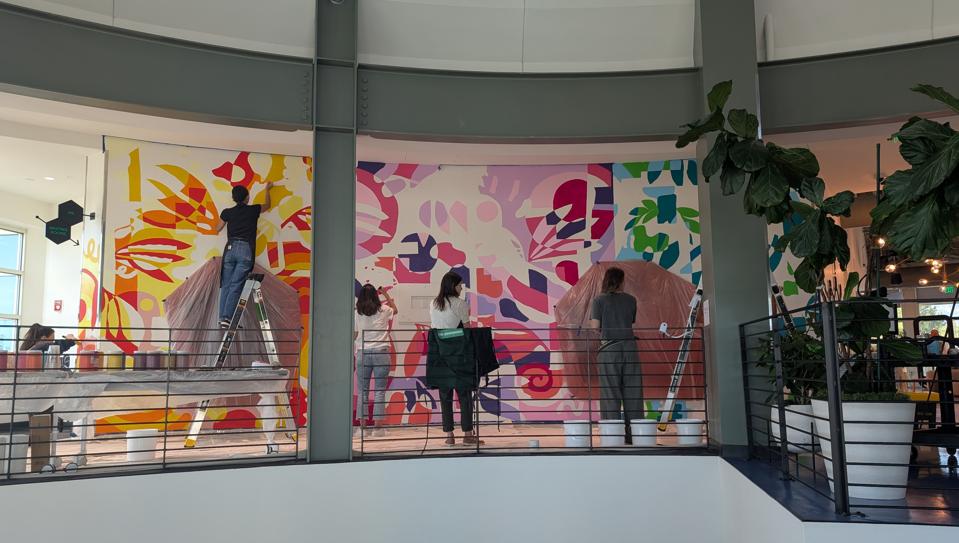Just two weeks ago, anybody who entered one particular central building on Google’s Boulder, Colorado, campus would have looked up from the atrium to see an unremarkable sight: a blank white wall, like the one that stretches from floors to ceilings of offices everywhere, encircling the level above.
Now, vivid swirls of color leap from that same rounded surface: yellow and rust spirals and waves echoing machine learning loops and communication signals, green roots representing networks of knowledge and fractal imagery reflecting complexity emerging from simple rules. Blossoming petals in shifting shades signify innovation and evoke Boulder’s outdoorsy spirit.
The symbols festoon an intricate new 30-foot mural, painted by more than 130 Google employees as part of a collaborative art project honoring the evolution of gTech, a global Google team that provides technical support and services to customers. Here, geometric shapes meet organic, free-flowing lines to tell a story that’s both technological and human.
“It’s perfectly abstract but also captures the spirit of growth and collaboration,” Emily Heilman, a senior content project lead who participated in the mural project, said in an email. “The colors are so pleasing to look at.”
Seven Years Of Google gTech
She and her co-workers painted the artwork during an annual gTech event called Synapse where employees at locations around the world explore new ideas. Each mural panel merges themes from the past seven gatherings. Assigned by gTech Vice President Emmanuel Saquet, these themes have included “Machine learning,” “Breaking barriers” and this year’s motto, “Grow. Connect. Inspire.” The mural has taken up residence in a building called Walnut.
The idea for a collaborative art project emerged as Synapse organizers in Boulder pondered creative possibilities for this year’s event. Alia Follett, an artist and Google global senior program manager, suggested mural making. She envisioned an experience that would coax code-minded problem solvers into the fluid, improvisational world of art — and result in distinctive and lasting office decor.
“We were trying to think of something that would push everyone out of their normal day-to-day energy,” Follett said in an interview.
It worked, especially for the many volunteers, like Heilman, who had never before wielded a paintbrush.
“They’d get maybe a little uncomfortable or awkward,” Follett said. “And then after painting for a couple of minutes, it was like something was unlocked. At least 10 people said to me. ‘I’ve been staring at a computer all day and this is the most relieving part of my week.’”
Volunteer painters chipped in from across gTech, and included members of the Gemini AI team, Pixel hardware strategists, user experience researchers and others.
Software engineer Deepti Mahesh said being part of the mural experience gave her a new appreciation for the organizational and logistical skills required to bring a creative vision to life. “Each day I realize more and more that creativity is a vital part of engineering and I’m glad that Google helps me inhabit and flourish in this cross-section,” she said.
Project participants worked in acrylic paint, and Follett — who designed the mural using digital mockups and pencil drawings oversaw its execution — welcomed improvisation.
“Some people started finger painting a little bit, some people wrote their name and then painted on top of it,” she said. “So many people brought different painting approaches: bold strokes, fine detail, abstract. At first it kind of looked mismatched, but then as the layers built up, the variety honestly made more richness in the design.”
With built-in seating embedded directly into the wall, the art installation doubles as a functional space for employees to work or socialize. As of this week, they can pause to admire their own handiwork.
“Every time I walk by it,” Heilman said, “I look at my little section that I painted and feel a part of something bigger.”

